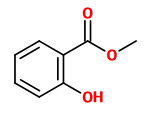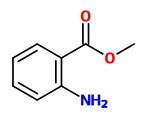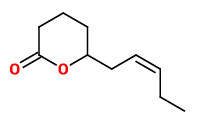Polianthes tuberosa L. - syn. Agave polianthes (L.) Thiede & Eggli - Agavoidae - tuberose, vara de San José (span.), Tuberose, Josefstab
Perennial plant, up to 1m tall, native to Mexico, ocultivated elsewhere (as cut flower); basal leaves narrow, long; upper leaves short, bright green, reddish at base; flowers in pairs in long terminal racemes, very fragrant, waxy white, funnel-shaped.
„Tuberose has a high reputation in perfumery. The plants are cultivated in Morocco, Egypt and India. A tuberose absolute was formerly produced in southern France by enfleurage (by enfleurage the volatiles from the freshly picked flowers are absorbed in paraffin shavings with subsequent alcoholic extraction), but now it is obtained by solvent extraction, via the concrete (see boronia for a description of this process). The absolute is a dark orange to brown viscous liquid with an extremely heavy-sweet, narcotic-floral and somewhat spicy odour reminiscent of honeysuckle, peru balsam, neroli, stephanotis, etc.“ http://www.bojensen.net/EssentialOilsEng/EssentialOils30/EssentialOils30.htm
Together with the saturated (R)-delta decalactone, tuberose absolute contained some unsaturated lactones like (S)-jasmine lactone, (R)-tuberolactone and (R)-massoialactone.
[Kaiser R., Lamparsky D., Tetrahedron Lett. 20, 1659, (1976)] see also
https://patentimages.storage.googleapis.com/b6/85/13/8e7109a8ca0d9d/WO1994007887A1.pdf
„Six unsaturated γ-lactones, (Z)-5-octen-4-olide, (Z)-5-decen-4-olide, (Z)-6-nonen-4-olide, (Z)-6-dodecen-4-olide, (Z,Z)-6,9-dodecadien-4-olide, and tuberolide have been identified for the first time in tuberose absolute (from Polianthes tuberosa L.).“
These components were detected in trace amounts (0.01-0.001%) but may contribute to the rich, heavy floral odor of tuberose absolute with creamy coconut, fatty aldehydic, and tenacious lactonic notes.
[Identification and Synthesis of New γ‐Lactones from Tuberose Absolute (Polianthes tuberosa)., Maurer, B., Hauser, A., Helvetica Chimica Acta, 65(2), 1982, 462-476]
There were major differences between the volatiles (headspace, Tenax) emitted from living tuberose flowers during the day and at night: Limonene (day 8% /night 14%), methyl salicylate (12%/6%), α-terpineol (11%/3.5%), methyl anthranilate (1%/3%), jasmin lactone (0.2%/1%), δ-dodecalactone (0.1%/0.6%).
[The chemistry of flowers, fruits and spices: live vs. dead-a new dimension in fragrance research., Mookherjee, B.D., Trenkle, R.W., Wilson, R.A., Pure and Applied Chemistry, 62(7), 1990, 1357-1364]
Products from single tuberose contained indole 0.11-0.69% (concrete) and 0.36-2.15% (absolute); from double tuberose 0.18-0.47% (concrete) and 0.64-1.47% (absolute).
[Indole in Tuberose (Polianthes tuberosa) varieties., Chandravadana, M.V., Srinivas, M., Murthy, N., Journal of essential oil research, 6(6), 1994, 653-655]
Main components of the concrete from supercritical CO2 extraction were 1,8-cineole, methyl benzoate, methyl salicylate, trans-methyl eugenol and benzyl benzoate.
[Mathematical modelling of supercritical CO 2 fractionation of flower concretes., Reverchon, E., Poletto, M., Chemical Engineering Science, 51(15), 1996, 3741-3753]
Yields of tuberose oil were: Cold enfleurage 0.3%, hot enfleurage 6.5%, hexane extract 0.028% and petroleum ether extract 0.018%. Components of the cold enfleurage absolute were methyl benzoate (30.1%), benzyl benzoate (23.6%), 7-decen-5-olide (13.3%), methyl salicylate (12.1%), methyl isoeugenol (8.8%), methyl anthranilate (4.4%), beta-farnesene (2.4%), methyl eugenol (1.8%), indole (1.7%), and citral (1.4%).
„Main chemical component detected in both enfleurage absolutes was methyl benzoate, while benzyl benzoate and pentacosane were found to be the main chemical components in hexane and petroleum ether absolutes, respectively.“
[Extraction Methods for Tuberose Oil and Their Chemical Components. Prapassorn Rakthaworn, Uraiwan Dilokkunanant, et al. Kasetsart J. (Nat. Sci.) 43 : 204 - 211 (2009)] http://kasetsartjournal.ku.ac.th/kuj_files/2010/a1003081301504218.pdf
Applying GC-MS to the floral scent of two fragrant and one not fragrant cultivar of P.tuberosa showed 1,8-cineole, methyl benzoate and methyl salicylate to be the characteristic components of the floral scent of tuberose.
[Analysis of the Floral Scent Compounds in Polianthes tuberosa L. Nan-Chen, Jen-Jen Hsi, Huey-Wen Chuang. J.Agric.For. (NCYU) 2010, 42 ff] http://tao.wordpedia.com/show_pdf.ashx?sess=oasi2d45e1z45gncleeijbes&file_name=JO00000420_7-1_32-42&file_type=r
Nitrogen compounds like N-formyl methyl anthranilate, N-methyl methyl anthranilate, indole (0.02-2%), methyl nicotinate, ethyl nicotinate (warm tobaco-like) and traces of skatol (flowery) certainly bring important contributions to the sweet heavy floral scent of tuberose absolute.
[Nicolas Baldovini, Jean-Jacques Filippi, „Natural Fragrant Raw Materials“ in: Buettner, Andrea, ed. Springer Handbook of Odor. Springer, 2017, 45-46; lit. cit.]

Edwards, S., Botanical Register, vol.1 t.63 (1815)
http://plantgenera.org/species.php?id_species=818646

Polianthes tuberosa, Mukkinada, Andhra Pradesh, India (2025) © Abhiram Kethineedi CC BY-SA 4.0 inaturalist.org
VIDEO: Tuberose from India (IFF-LMR)




